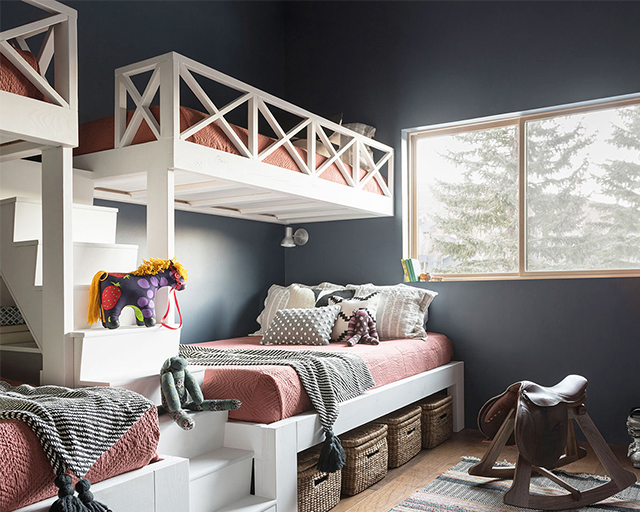An Experts’ Guide to Designing Dark-Hued Rooms
 Design by Lucy Interior Design.
Design by Lucy Interior Design.
The sophistication of a beautifully designed dark-walled room can make even the most ardent fans of white paint consider taking the plunge. Intriguing, inspiring, and occasionally introspective, these spaces can be the perfect backdrops for relaxing, conversing, or quiet reflection. For those who might be considering updating a room with a moody hue, we asked four scouted interior designers from across the country to share advice on how to best employ a darker shade in an area. Here, they share tips and recommendations on everything from ideal colors to creating contrast and more.
Embrace the darker side. “Not for the faint of heart, dark and moody interiors create intrigue, curiosity, and invite introspection,” Lucy Penfield, design principal at Lucy Interior Design in Minneapolis, Minnesota, explains. “Although we are drawn to interiors that are light and bright, like a beacon of sunlight, we also welcome the quiet moodiness of rooms wrapped with deep, dark colors.” She explains that entering a room with a rich color connects us to the earth. Forest greens, smoky blues, aubergine, terracotta, and cabernet have the ability to soothe, console, and comfort. Jessica Dodson McIntyre, owner and principal designer at Jessica McIntyre Interiors in Fort Worth, Texas, notes that it’s important to recognize that a room comprised of dark materials will always appear dark, no matter how much light is in the space. If you’re on board with this, then proceed with creating a lovely, layered room. If not, perhaps you should opt for a different palette.
 Design by Lucy Interior Design. Photography by Lucy Call.
Design by Lucy Interior Design. Photography by Lucy Call.
Aim to evoke a cozy ambiance. Creating spaces with dark backdrops can take different routes. You can add light via bright, shiny accents or lean into the dark vibes to create a cocoon-like experience. If you go in the direction of the latter, “Dark textiles, with rich velvet or age-old tapestries, pair perfectly with deep hues,” Penfield says. Papering the walls with mural-like wall coverings or bold, large-scaled designs provides this same enveloping sense. “It’s almost as if the darker the palette the more storied and layered the room feels, creating mystery and intrigue,” she notes.
 Design by Design Matters. Photography courtesy of Design Matters.
Design by Design Matters. Photography courtesy of Design Matters.
Create contrast. Many shy away from dark hues for fear that the room will end up feeling oppressive and gloomy. According to Julie Cavanaugh, founder and principal interior designer at Design Matters in Jackson Hole, Wyoming, the effect can be quite the opposite when done right. Creating a contrast between a dark foundation and lighter elements, such as lighting, hardware, and accessories, can bring a lovely vibrancy to a room. “The juxtaposition and contrast between dark and light colors and finishes plays into the overall look and delivers a moody, rich, and cozy atmosphere.”
 Design by Jessica McIntyre Interiors. Photography by Jenifer McNeil Baker.
Design by Jessica McIntyre Interiors. Photography by Jenifer McNeil Baker.
Introduce texture. In order to keep a dark-hued space from feeling heavy and one-note, McIntyre creates crucial contrast by using materials that have variation in texture and finish. For example, in the “his” portion of the “his and her” bathroom featured above, she chose wall tile that has dimension to it and utilized light to accent the tile’s depth.
Remember that dark doesn’t have to mean masculine. It’s true that certain moody rooms can evoke a men’s lounge vibe. But Penfold notes that a dark color palette pairs equally well with feminine touches like rock crystal chandeliers and wall sconces that add light and sparkle as it does with mahogany and aged leather. She adds that dark interiors also welcome the dapple of copper and patina of aged brass, which are perfect for bouncing off light.
 Design by Allard and Roberts Interior Design. Photography courtesy of Allard and Roberts.
Design by Allard and Roberts Interior Design. Photography courtesy of Allard and Roberts.
Know that appropriate lighting is crucial. “Natural light and room lighting are key when selecting darker wall colors for a room,” Talli C. Roberts-Early, principal interior designer at Allard and Roberts Interior Design in Asheville, North Carolina, says. Layering can go a long way, as Roberts-Early did in the above dining room utilizing recessed cans, two pendant lights over the table, and wall sconces flanking the large picture window. She adds that it’s crucial to install dimmers on fixtures so you can adjust the desired ambience, and says that having lighting at different heights within a room adds interest.
Opt for accents that add softness. To keep things from feeling or looking too heavy and dark, Cavanaugh chooses items that mellow the moody space while paying attention to scale and weight. When appropriate, Roberts-Early likes to utilize a contrasting scheme of light fabrics with deeper walls, like the gauzy window treatments in her dining room project featured above. By incorporating sheen in the wall covering and the area rug, she introduces balance and dimension, taking the dark-walled room to the next level.
TSG Tip 407 from Lucy Penfield, design principal at Lucy Interior Design in Minneapolis, Minnesota; Jessica Dodson McIntyre, owner and principal designer at Jessica McIntyre Interiors in Fort Worth; Julie Cavanaugh, founder and principal interior designer at Design Matters in Jackson Hole, Wyoming; and Talli C. Roberts-Early, principal interior designer at Allard and Roberts Interior Design in Asheville, North Carolina. Lucy Interior Design appears in The Scout Guide Minneapolis. Jessica McIntyre Interiors appears in The Scout Guide Fort Worth. Design Matters appears in The Scout Guide Jackson Hole. Allard and Roberts Interior Design appears in The Scout Guide Asheville.




